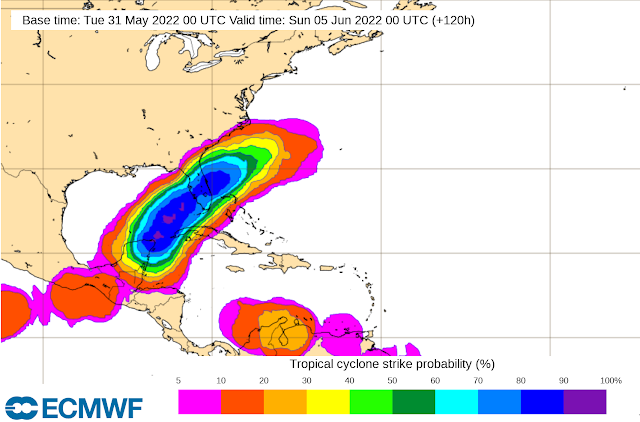As former-Hurricane Agatha treks northward across Mexico's Isthmus of Tehuantepec and weakens, there is a growing probability of it redeveloping in the Yucatan area later this week. If it achieves tropical storm status, the first name on this year's list is Alex. Alex replaced Andrew in this list after the 1992 hurricane season.
This is the same system I described in last Wednesday's post. As of Tuesday morning, the National Hurricane Center is giving it a 60% probability of becoming at least a tropical depression once it's over water.
These "crossover" storms (Pacific to Atlantic or vice versa) occur now and then; it's certainly not unprecedented. Last year, Grace (Atlantic) crossed into the Pacific and became Marty. Similarly for Nana -> Julio in 2020... and the last time a storm went from the Pacific and redeveloped in the Atlantic was Amanda -> Cristobal in 2020.
Even if this system ends up not taking the first name, 2022 can already claim the latest first named storm formation since 2014!
As far as model guidance goes, the European model has consistently been more aggressive than the American model in re-developing it and bringing higher rainfall totals to Florida. This doesn't necessarily mean it will be right, but it has been the most consistent for several days now. Other models keep it more diffuse and complicated, actually extending the period over which heavy rain is possible. The map below shows the probability of a tropical cyclone strike (at least a tropical depression) in the coming five days from the European model ensemble.
Regardless of development, a swath of heavy rain is likely across west Cuba and then south Florida in the coming days. The low pressure or tropical cyclone could reach south Florida as early as Friday, or as late as Sunday, with the highest likelihood on Saturday. Models are indicating the potential for extremely heavy rainfall in south Florida, perhaps in the 6-12 inch range. The graphic below is the latest 7-day rainfall forecast from the NOAA Weather Prediction Center (Tuesday morning through Tuesday morning). That little light-yellow blotch over the south tip of the peninsula is the 10-15-inch category.
The Atlantic hurricane season officially begins tomorrow.
- Visit the Tropical Atlantic Headquarters.
- Subscribe to get these updates emailed to you.
- Follow me on Twitter









